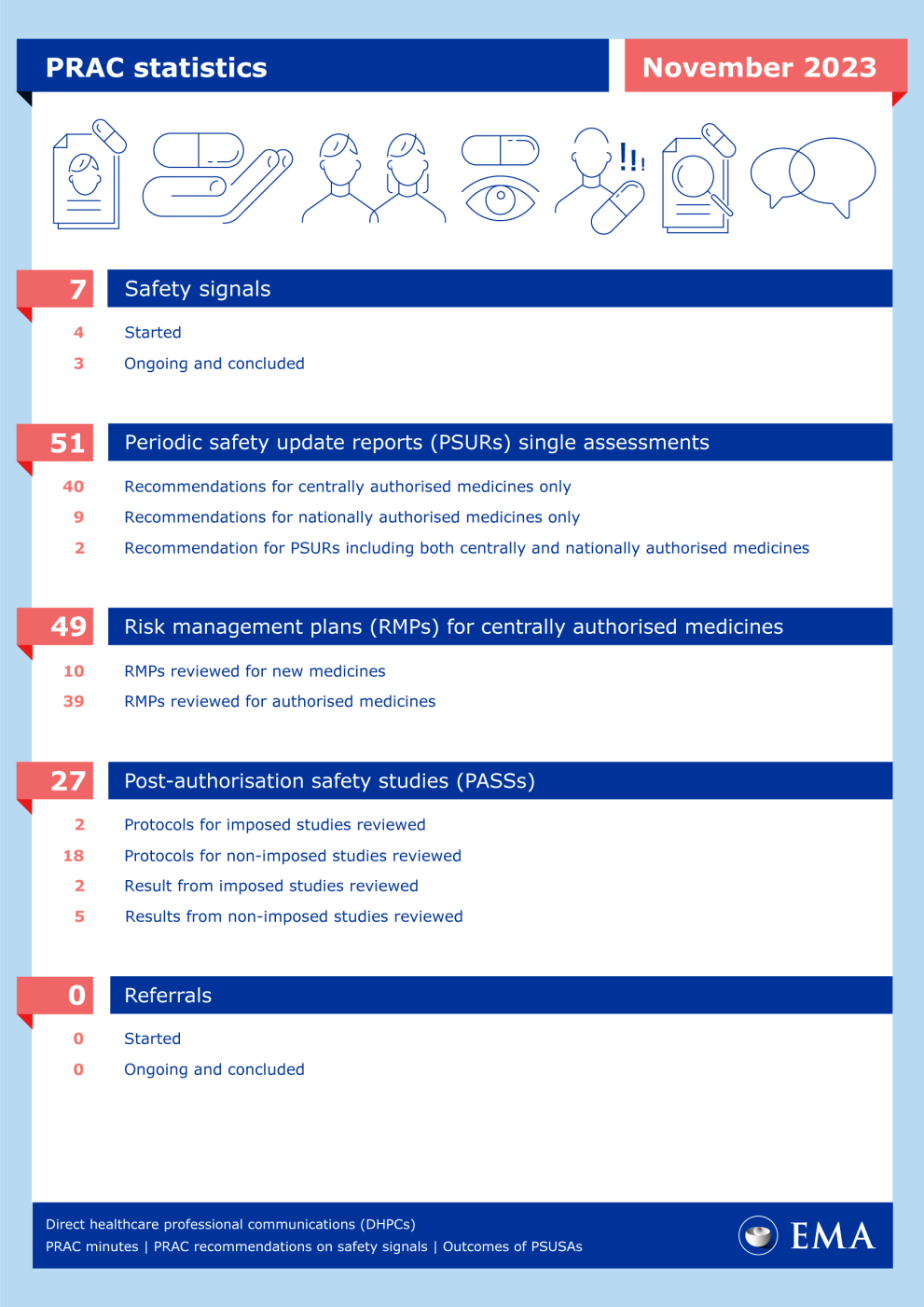Meeting highlights from the Pharmacovigilance Risk Assessment Committee (PRAC) 23-26 October 2023
NewsHumanPharmacovigilanceReferrals
EMA’s safety committee (PRAC) has concluded that the available evidence does not support a causal association between the Glucagon-Like Peptide-1 Receptor Agonists (GLP-1) - exenatide, liraglutide, dulaglutide, semaglutide, and lixisenatide - and cancer of the thyroid (a small gland in the front and lower part of the neck which makes and releases hormones).
GLP-1 receptor agonists are used to treat type 2 diabetes and, in some cases, for the treatment of obesity and overweight under certain conditions. The PRAC began assessing this safety signal following the publication of a study1 suggesting that there might be an increased risk of thyroid cancers with the use of these medicines in patients with type 2 diabetes mellitus.
The committee reviewed evidence from the published literature, including observational studies (Bezin et al1, 2022; Alves et al2, 2012; Hu et al3, 2022; Bea et al4, 2023) as well as cumulative data submitted by the marketing authorisation holders (MAHs) which included non-clinical, clinical and post-marketing data. At present, the PRAC considers that no updates to the product information are warranted based on the available data.
The MAHs for liraglutide- (including Victoza, Saxenda, Xultophy), semaglutide- (including Ozempic, Rybelsus, Wegovy), exenatide- (including Bydureon, Byetta), dulaglutide- (i.e.Trulicity) and lixisenatide- (including Lyxumia, Suliqua) containing products should continue to monitor these events closely, including any new publications, as part of their pharmacovigilance activities and report any new evidence on this issue in their Periodic Safety Update Reports (PSURs).
1 Bezin et al. GLP-1 Receptor Agonists and the Risk of Thyroid Cancer. Bezin et al. 2022 Diabetes Care. 2022 Nov 10; dc221148. doi: 10.2337/dc22-1148. (Online ahead of print)
2 Alves C, Batel-Marques F, Macedo AF. A meta-analysis of serious adverse events reported with exenatide and liraglutide: acute pancreatitis and cancer. Diabetes Res Clin Pract. 2012 Nov;98(2):271-84. doi: 10.1016/j.diabres.2012.09.008. Epub 2012 Sep 23. PMID: 23010561.
3 Hu W, Song R, Cheng R, Liu C, Guo R, Tang W, Zhang J, Zhao Q, Li X, Liu J. Use of GLP-1 Receptor Agonists and Occurrence of Thyroid Disorders: a Meta-Analysis of Randomized Controlled Trials. Front Endocrinol (Lausanne). 2022 Jul 11;13:927859. doi: 10.3389/fendo.2022.927859. PMID: 35898463; PMCID: PMC9309474.
4 Bea S, Son H, Bae JH, Cho SW, Shin JY, Cho YM. Risk of thyroid cancer associated with glucagon-like peptide-1 receptor agonists and dipeptidyl peptidase-4 inhibitors in patients with type 2 diabetes: A population-based cohort study. Diabetes Obes Metab. 2023 Sep 21. doi: 10.1111/dom.15292. Epub ahead of print. PMID: 37735822.

|
Procedure |
Status |
Update |
|---|---|---|
| Pseudoephedrine-containing medicinal products - Article- 31 referral | Under evaluation | PRAC continued its assessment |
| Hydroxyprogesterone-containing medicinal products – Article-31 referral | Under evaluation | PRAC continued its assessment |